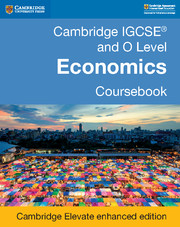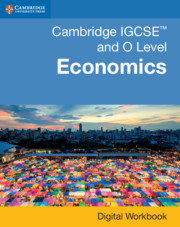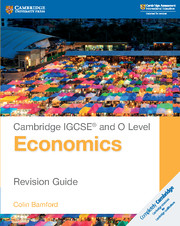This Cambridge Elevate enhanced edition helps students apply tools of economic analysis, make judgements on economic issues, use basic economic numeracy and literacy, and take greater part in decision-making processes in everyday life. It provides a foundation for advanced study in Economics such as A Level. This digital resource contains exam-style questions and auto-marked questions with feedback in every chapter, ensuring students have plenty of materials for self-study. Answers to the coursebook questions are in the teacher's resource.
Features
- Personalise Cambridge Elevate enhanced editions to your needs – set homework, link to the web and share annotations with your class.
- Exam-style questions in every chapter provide students with opportunities to practice their skills and build confidence.
- Equips students with an understanding of the language of Economics and supports the development of their evaluative skills with essay questions.
- Key terms highlight and explain important concepts, helping students produce clear and accurate answers.
- A range of new practice exercises builds students' Economics skills and confidence with the subject.
- Group activities encourage peer support and provide opportunities for students to express themselves.
- Introduces topics and presents economic concepts in the context of the learner, making Economics relevant to everyday life.
- Simple and easy to use, link directly into Cambridge Elevate from Moodle, Blackboard and any other VLE.
- Cambridge Elevate enhanced is simple to navigate for both students and teachers – find notes quickly with highlights and bookmarks.
- Access a library of Cambridge books anywhere, anytime whether online or offline (via the app). For more information, please visit elevate.cambridge.org/support.
Table of Contents
- Introduction
- Section 1. The basic economic problem
- Chapter 1. The nature of the economic problem
- Chapter 2. Factors of production
- Chapter 3. Opportunity cost
- Chapter 4. Production possibility curves
- Examination practice
- Section 2. The allocation of resources
- Chapter 5. Microeconomics and macroeconomics
- Chapter 6. The role of markets in allocating resources
- Chapter 7. Demand
- Chapter 8. Supply
- Chapter 9. Price determination
- Chapter 10. Causes of price changes
- Chapter 11. Price elasticity of demand
- Chapter 12. Price elasticity of supply
- Chapter 13. Market economic system
- Chapter 14. Market failure
- Chapter 15. Mixed economic system
- Examination practice
- Section 3. Microeconomic decision makers
- Chapter 16. Money and banking
- Chapter 17. Households
- Chapter 18. Workers
- Chapter 19. Trade unions
- Chapter 20. Firms
- Chapter 21. Firms and production
- Chapter 22. Firms' costs, revenue and objectives
- Chapter 23. Market structure
- Examination practice
- Section 4. Government and the macroeconomy
- Chapter 24. The role of government
- Chapter 25. The macroeconomic aims of government
- Chapter 26. Fiscal policy
- Chapter 27. Monetary policy
- Chapter 28. Supply-side policy
- Chapter 29. Economic growth
- Chapter 30. Employment and unemployment
- Chapter 31. Inflation and deflation
- Examination practice
- Section 5. Economic development
- Chapter 32. Living standards
- Chapter 33. Poverty
- Chapter 34. Population
- Chapter 35. Differences in economic development between countries
- Examination practice
- Section 6. International trade and globalisation
- Chapter 36. International specialisation
- Chapter 37. Free trade and protection
- Chapter 38. Foreign exchange rates
- Chapter 39. Current account of the balance of payments
- Examination practice
- Index.
Advice on useful tools
Advice on useful tools, activities and timetabling from teachers experiencing school closures.
Cambridge GO
All our supporting resources have now moved to Cambridge GO – the new home for your Cambridge digital content.
Listen to our podcast
Listen to our podcast to discover teaching inspiration & advice from leading educational thinkers.








